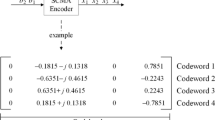Abstract
The conventional Direct-Sequence Spread-Spectrum-Multiple-Access (DS-SSMA) system with RAKE-receiver is an interesting approach in mobile communications in order to combat the frequency selectivity of the channel. The main advantages of DS-SSMA are well known, but its capacity is limited by other-user interference. Another interesting SSMA technique that combats the frequency selectivity of the channel and achieves high spectral efficiency is based on Orthogonal-Frequency-Division-Multiplexing (OFDM). This new SSMA technique combines the principles of DS-SSMA with OFDM and is called Multi-Carrier Spread-Spectrum-Multiple-Access (MC-SSMA). By providing high frequency diversity, this combination enables the possibility to perform a maximum-likelihood detection (MLD) resulting in high performance/capacity, to use the spectrum in an efficient way and to retain many advantages of the conventional DS-SSMA system. In addition, it allows both simple cell-separation by using frequency hopping and simple hardware realization. An example for the downlink of a mobile communications system, i.e. the transmission from the base station to a mobile station, using MC-SSMA with Walsh-Hadamard code spreading is studied. Different coherent detection algorithms such as conventional detection, MLD, and iterative detection are analyzed. The analytical performance of MLD is evaluated. It is also shown analytically, and by simulations that the MC-SSMA system with MLD outperforms the DS-SSMA system with RAKE-receiver. Up to 64 active users can be transmitted in a 1.25 MHz bandwidth. Each user has a rate of 16.0 kbit/s by using BPSK modulation. At a signal to noise ratio (SNR) of 13 dB a bit error probability ofP b =10−3 can be guaranteed without channel coding. This results in a spectral efficiency of about 0.8 bit/s/Hz. Under the same conditions the conventional DS-SSMA system results in a spectral efficiency of about 0.15 bit/s/Hz. Hence, using MC-SSMA for the downlink of a cellular mobile communications system is a promising approach.
Similar content being viewed by others
References
P. Bello, “Characterization of randomly time-variant linear channels”, IEEE Trans. Commun., pp. 360–393, 1963.
G. L. Turin, “Introduction to spread-spectrum antimultipath techniques and their applications to urban digital radio”, Proceedings of the IEEE, Vol. 68, pp. 328–353, 1980.
M. Chase and K. Pahlavan, “Performance of SSMA orthogonal codes over measured indoor radio channels”, in IEEE, Proc. Conf. ICC'91,pp. 16A.2.1–16A.2.5, 1991.
J. G. Proakis, Digital Communications, second ed. McGraw-Hill, 1989.
L. Milstein, “Interference rejection techniques in spread spectrum communications”, IEEE Proceedings, Vol. 75, pp. 211–222, 1988.
J. Ketchum and J. Proakis, “Adaptive algorithms for estimating and suppressing narrow-band interference in PN spread-spectrum systems”, IEEE Trans. Commun., Vol. 30, pp. 913–924, 1982.
S. Weinstein and P. M. Ebert, “Data transmission by frequency-division multiplexing using the discrete Fourier transform”, IEEE Trans. Commun., Vol. 19, pp. 628–634, 1971.
M. Alard and R. Lasalle, “Principles of modulation and channel coding for digital broadcasting for mobile receivers”, EBU Review, pp. 47–69, 1987.
M. Failli, “Digital land mobile radio communications”, Tech. Rep. COST-207, 1989.
D. Cox and R. Leek, “Distributions of multipath delay spread and average excess delay for 910 MHz urban mobile radio paths”, IEEE Transactions on Antennas and Propagations, Vol. AP-23, pp. 206–213, 1975.
J. Massey and T. Mittelholzer, “Technical assistance for the CDMA communications system analysis”, Tech. Rep. 8696/89/NL/US, ESTEC Contract, 1991.
M. Williams and D. Sloane, The Theory of Error-Correcting Codes, second ed. North-Holland Mathematical Library, 1978.
K. Fazel, “Performance of CDMA/OFDM for mobile communication system”, in IEEE, 2nd International Conference on Universal Personal Communications (ICUPC) Proc, pp. 975–979, 1993.
P. Hoeher, “TCM on frequency-selective land-mobile fading channels”, in 5th Tirrenia Intern. Workshop on Digital Communications, Pisa, Elsevier Science Publishers, pp. 321–329, 1991.
M. B. Pursley, “Performance evaluation for phase-coded spread-spectrum multiple-access communications. Part I: System analysis”, IEEE Trans. Commun., Vol. 25, pp. 795–799, 1977.
E. Geraniotis and B. Ghaffari, “Performance of binary and quaternary direct sequence spread-spectrum multiple-access systems with random signature sequences”, IEEE Trans. Commun., Vol. 39, pp. 713–724, 1991.
M. Kavehrad, “Performance of nondiversity receivers for spread spectrum in indoor wireless communications”, AT&T Technical Journal, Vol. 64, pp. 1181–1210, 1985.
M. Schnell and M. Werner, “Comparison between different transmission schemes for mobile radio channels”, in Conference Proceedings of the International Symposium on Signals, Systems, and Electronics (ISSSE), pp. 705–708, 1992.
M. Kavehrad and P. McLane, “Performance of low-complexity channel coding and diversity for spread spectrum in indoor, wireless communications”, AT&T Technical Journal, Vol. 64, pp. 1927–1965, 1985.
S. Kaiser, “OFDM-CDMA versus DS-CDMA: Performance evaluation for fading channels”, in Proc. for IEEE International Conference on Communications (ICC) '95, pp. 1722–1726, 1995.
D. Divsalar and M. K. Simon, “The design of trellis coded MPSK for fading channels: Performance criteria, IEEE Trans. Commun., Vol. 36, pp. 1004–1012, 1988.
R. G. McKay, P. J. McLane, and E. Biglieri, “Error bounds for trellis-coded MPSK on a fading mobile satellite channel”, IEEE Trans. Commun., Vol. 39, pp. 1750–1761, 1991.
K. Fazel, “Narrow-band interference rejection in orthogonal multi-carrier spread-spectrum communications”, in IEEE, 3rd International Conference on Universal Personal Communications (ICUPC) Proc, pp. 46–50, 1994.
Author information
Authors and Affiliations
Additional information
Part of this work was carried out within the CODIT project in the RACE-2 programme organized by the CEC and was supported by PKI-AG, Germany.
Rights and permissions
About this article
Cite this article
Fazel, K., Kaiser, S. & Schnell, M. A flexible and high performance cellular mobile communications system based on Orthogonal Multi-Carrier SSMA. Wireless Pers Commun 2, 121–144 (1995). https://doi.org/10.1007/BF01099534
Issue Date:
DOI: https://doi.org/10.1007/BF01099534




